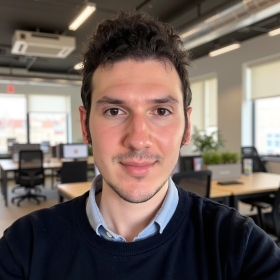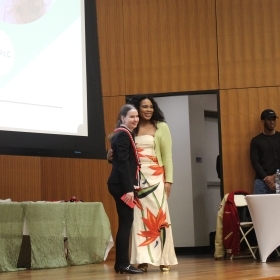Prioritizing Your Mental Health in the Workplace: Q&A with Priscilla O. Agyeman ’16C

Balancing mental health and work responsibilities can be a challenging task. However, it is crucial to prioritize your well-being and seek support when needed to achieve personal growth and career success.
During this Q&A session, we speak with Priscilla O. Agyeman ’16C, a St. John’s alumna and mental health advocate. She shares her personal experience with mental health issues and the strategies she uses to navigate mental health in the workplace successfully. She also discusses the mental health resources she offers through her company, Saddie Baddies®.
I. Early Experiences: Managing Mental Health Issues in College
Could you share an early experience where you managed your mental health?
During my years as a student earning my undergraduate degree in St. John’s College of Liberal Arts and Sciences, I dealt with anxiety attacks that began during my sophomore year.
I vividly remember my first panic attack on campus was in my dorm room. My roommate noticed my distress and showed her care by making my lunch and organizing my clothes. Although she didn’t fully understand what was happening to me, her support was invaluable.
I went home that weekend to see my parents, who immediately noticed my weight loss and became concerned. As someone who has always been self-assured, they were confused about what was happening. Looking back, I realized that I needed to take control of my mental health and seek help.
When did you realize that prioritizing your mental well-being was necessary? What did your path to healing entail?
In graduate school, I still experienced panic attacks intermittently. However, I gradually came to understand that this was a mental health issue. Consequently, I took the step of seeking therapy—and that marked the beginning of my healing journey. From then on, I started asking for help and making positive changes in my life.
My healing journey was a combination of therapy, meditation, and self-reflection. Although challenging, I needed to regain balance and peace in my life. Starting your healing journey involves seeking help and making positive changes to feel and become better.
II. The Importance of Prioritizing Mental Health at Work
What are some signs of mental illness? How does this manifest in the workplace?
Mental illness can manifest in different ways, such as irritability, feeling bothered by everything without knowing why, brain fog, trouble sticking to a routine, isolation, and not wanting to be around people, even loved ones.
It’s essential to recognize these signs and seek help if you need it. Sometimes, showing up as your complete self in the workplace can be challenging, especially if you feel uncomfortable sharing your identity or cultural background. You may need to hide who you are to be accepted by your colleagues, which can be stressful and triggering. If you’re experiencing these symptoms, it may be time to ask for help.
What was the primary factor that affected your mental health during the early stages of your career?
In my experience, not having a healthy work-life balance was a significant contributing factor to my mental health struggles.
I found myself neglecting self-care and my overall well-being in favor of work. In contrast, at other times, I was so deep in the pit of my mental health issues that I couldn’t function and do my job correctly. At times, going through the motions at work and not wanting to be present can be a sign of burnout or disengagement.
III. Ms. Agyeman’s Self-Care Strategies
What self-care practices do you prioritize while working remotely?
I make sure to take care of myself, even when working remotely. I still follow my usual morning routine of taking a shower, doing my skincare regiment, and even applying a little makeup to make me feel like I’m going to an office.
Putting on proper clothes, even if it’s just a button-down shirt with biking shorts underneath, helps me feel present and focused throughout the day. Taking care of myself mentally and physically is essential, starting with maintaining a consistent morning routine.
How can individuals prioritize their mental health at work?
Taking mental health days is essential. You can only perform at your best in the right headspace. Many companies have policies and federal laws allowing short-term medical leave. Self-preservation should always come first.
On a smaller scale, incorporating microbreaks into your routine can make a big difference. Starting and ending your day with activities that fulfill you can significantly impact your overall well-being. It’s about finding what works for you, whether it’s a few moments of mindfulness or engaging in activities you enjoy.
Regarding time off, if your company offers paid time off (PTO), don’t hesitate to use it. There’s no reward for not using it. Get creative with scheduling, like extending holiday weekends for minigetaways or staycations. It’s about maximizing the time you need to recharge and prioritize your mental health.
I understand the challenges firsthand as I had a job with strict leave policies. But with creativity and prioritization, you can find ways to care for yourself within the confines of workplace policies. Your well-being is paramount and worth advocating for.
In your experience, how important do you feel disconnecting from work during leisure time is? What are the potential consequences of neglecting personal interests?
Having hobbies and interests outside of work is crucial for our mental health. Your job should not define you, even if you love what you do. If you feel like your work is taking over your life, remember what you enjoyed doing in your childhood. These activities are the most authentic and genuine versions of yourself. If you can reconnect with a hobby—whether it is running, cooking, baking, painting, art, reading, or anything else that brings you joy—it can help you feel more connected to yourself.
During the weekend, I always make sure to do at least one fun activity that is entirely unrelated to work. It doesn’t have to be something that can be monetized or turned into a business; it can be just silly and enjoyable, like taking a workout class or baking cookies. These hobbies are essential for our wellness, but are often overlooked. They add fulfillment and roundness to our lives and should be prioritized just as much as other wellness practices like meditation.
IV. Ms. Agyeman’s Entrepreneurial Journey: Advocating for Mental Health
Could you tell us about your company, Saddie Baddies®, and how you promote mental wellness and self-care?
Saddie Baddies® is a digital media company and lifestyle brand disrupting the status quo of mental and emotional health care and well-being for young, diverse communities. We provide digital products such as the podcast The Soft Life with Saddie Baddies®; a self-care guide, My Journey to Self-Love: the Ultimate Guide Self-Care Guide by Saddie Baddies®, and curated services such as guest speaking, workshops, in-person and virtual events, and creative brand partnerships/content creation.
Since we are a Black woman-owned and founded company, Saddie Baddies® always ensures that its digital media content, including the podcast and self-care guide, reflects diverse voices and experiences. It’s our mission and purpose as a company to remove the stigma that surrounds mental health in our communities, as there are historical and present-day implications and limitations to accessing effective mental health care for youth with these intersectional identities.
Our self-care guide and current primary product offering, My Journey to Self-Love: the Ultimate Guide Self-Care Guide by Saddie Baddies®, uses culturally competent strategies and resources that resonate with diverse individuals’ unique experiences and challenges. Saddie Baddies® also designs workshops and events explicitly addressing the mental health needs of these identified communities. Topics include being Black in the workplace, navigating growing up as a first-generation American, and fostering acceptance and resilience for LGBTQIA+ youth.
Can you give an example of a mental wellness resource Saddie Baddies® offers?
One of the resources we offer is a self-care morning and night menu, which can be found in our self-care guide. The morning menu is a simplified routine consisting of five activities you list and then select three per day. You can choose from activities such as journaling, walking, doing a quick workout, walking your dog, or doing something creative in the morning. The idea is to adapt to what works for you instead of copying someone else’s routine.
The morning and night menu content we share helps people tailor their routines to their lives and create a sustainable environment for them to thrive. It’s a framework that you can always fall back on, even when life is unpredictable. It allows you to care for yourself and feel accomplished, even on the most chaotic days. In today’s fast-paced world, taking small moments of joy, positivity, or stillness can bring hope for the day. Our platform aims to help people create a customized mental health routine that works for them.
V. A Final Piece of Advice
What advice would you give for navigating personal and professional mental health?
Prioritize self-check-ins and connect with a support system. Your support system can be composed of various things, such as the people you live with, or, if you’re a college student, the clubs and activities that you are in that are related to your interests. Finding your people—even if it’s just one or two—can help you feel less alone and more supported.
Additionally, advocating for yourself and asking for support when needed is essential. For instance, you can ask your professors for additional resources, such as annotations or summaries of class discussions. You can ask for similar support in the workplace.
Lastly, take advantage of any resources available to you. Remember that maintaining good mental health is essential to overall well-being and success.
Thank you, Ms. Agyeman, for sharing your invaluable insights! To stay connected and explore more about mental wellness and self-care, consider the following:
- Connect with Priscilla O. Agyeman on LinkedIn for further discussions and updates.
- Follow Saddie Baddies® on Instagram and YouTube to access helpful resources and stay updated on their initiatives.
- Visit the Saddie Baddies® website to explore their digital products, workshops, and events promoting mental and emotional well-being.






